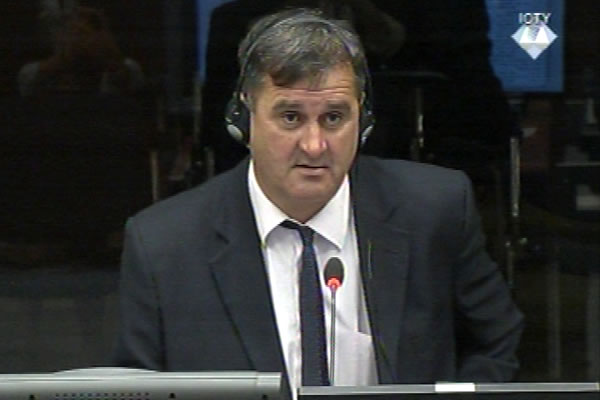Home
‘DOUBLE RING’ AROUND SARAJEVO
Predrag Trapara who commanded a VRS company in Lukavica during the war, testified in Ratko Mladic’s defense. In a bid to show that the two armies in Sarajevo were evenly matched, Trapara argued that his unit formed part of a Serb ring around Sarajevo. Another ring, manned by the Muslim forces, was positioned behind the Serbs’ backs, on the dominant hills around the city
 Predrag Trapara, defence witness at Rako Mladic trial
Predrag Trapara, defence witness at Rako Mladic trial Ratko Mladic’s defense case began On Monday. The case continued with the testimony of Predrag Trapara, former commander of a company in the Sarajevo-Romanija Corps stationed in Lukavica. Trapara has already testified in the defense of General Dragomir Milosevic and Radovan Karadzic. In a statement to Mladic’s defense the witness repeated the key arguments presented at previous trials. Trapara attempted to present the situation in Sarajevo as a clash of two armies that were equal in strength, to challenge the allegations in the indictment about the artillery and sniper terror campaign pursued by the units under the command of the accused against the civilians in the besieged city.
In the summary of the statement, read out by defense counsel Branko Lukic, the witness claimed that at the beginning of the war the frontlines around Sarajevo were established when Serbs and Muslims ‘got out of their houses and dug themselves in’. According to Trapara, for the most part the frontlines remained unchanged: one of the reasons was the fact that the Serb side ‘didn’t take any offensive actions’ and managed to repel the enemy attacks. Trapara said that he had neither received nor sent any orders to terrorize the citizens in the city. The only orders were to attack enemy positions, the witness explained. On the other hand Trapara claimed that the Muslim side attacked Serb civilians, noting that his parents had been injured in two separate incidents. The Muslim artillery targeted the Serb territory and snipers were their ‘mainstay’, Trapara said, adding that the enemy used civilian facilities for military purposes.
In a brief examination-in-chief the witness noted that his company manned two frontlines, one in front of them, facing the city, and one behind them, facing Mount Igman and Mount Bjelasnica, as a result of the fact that Sarajevo was ‘surrounded by two rings’. In his answers to the prosecutor, Trapara said that during the war he had seen accused Mladic two times. Trapara saw Mladic first at Vrace in May 1992, and then on 12 July 1993 in Lukavica when Mladic shook hands with his soldiers. Mladic told the fighters that ‘as of tomorrow you will not see other insignia on caps but the Serb tricolor’.
Before the cross-examination the judges asked the witness to clarify several issues. The judges asked Trapara to comment on a quote from a document where Radovan Karadzic ordered the troops to let the humanitarian convoys into the city and to ‘stop the military offensive operations’. According to the witness, there were no military offensive actions. When he saw the document, Trapara said that he ‘didn’t say Serbs had not carried out any offensive actions’. What he meant was that such offensive actions were carried out in other sectors, just not in the sector covered by his company. The witness argued that the Serb side never prevented humanitarian convoys from passing. This prompted presiding judge Orie to bring up another document in which the troops were ordered to stop the humanitarian convoys following the murder of two Serb girls in March 1995. Trapara said that he had been unaware of the order. In fact, he may have ‘unwittingly violated’ the order because he always let the convoys pass into the city, Trapara explained.
In the cross-examination, prosecutor Milbert Shin went over the maps with the frontlines of the Bosnian Serb Army and the BH Army around Sarajevo in great detail, with special attention to the artillery positions. Prosecutor Shin also showed the witness some documents according to which Stanislav Galic, the Sarajevo-Romanija Corps commander, ordered that 30-strong sniper platoons be established in each brigade in the Sarajevo area. This contradicts the witness’s claim about the ‘sniper supremacy’ of the other side. Trapara didn’t contest the suggestion but said that his company didn’t have sniper rifles. His unit didn’t need them because its positions were below to the BH Army positions. The prosecutor went on to suggest that the Serb shelling had been ‘heavier’ than the Muslim artillery attacks. The witness agreed in part, saying that the statement may have been true at the beginning. From the mid part of the war until its end, the two sides were even when it came to artillery attacks, Trapara claimed. At the end of the cross-examination the witness was asked about his involvement in the pre-war arming of Serbs in Sarajevo, which led to his arrest and conviction by the former JNA.
As the hearing today drew to a close, Mladic’s third defense witness Dusan Skrba began his evidence. Skrba used to be the commander of the Mixed Artillery Battalion in the 1st Sarajevo Brigade.
Linked Reports
- Case : Mladic
- 2014-05-19 RATKO MLADIC’S DEFENSE KICKS OFF
- 2014-05-17 APPEALS CHAMBER TO CONSIDER MLADIC’S ‘HALF-TIME’ JUDGMENT
- 2014-05-12 MLADIC’S DEFENSE WITHOUT OPENING STATEMENT
- 2014-05-21 WAS SARAJEVO UNDER BLOCKADE?
- 2014-05-22 ‘NEIGHBORLY AGREEMENT’ ON POPULATION EXCHANGE
- 2014-05-23 DISCREPANCIES BETWEEN DOCUMENTS AND WITNESS’S EVIDENCE
